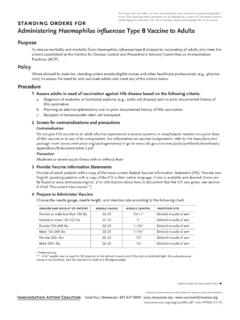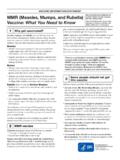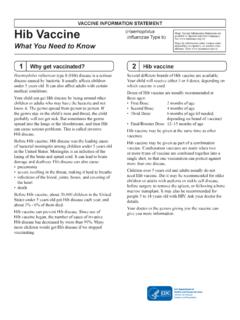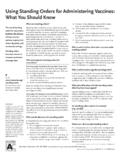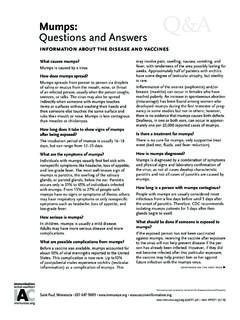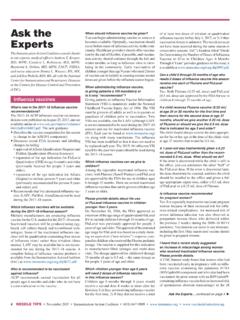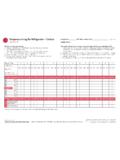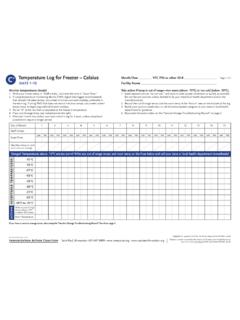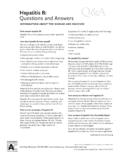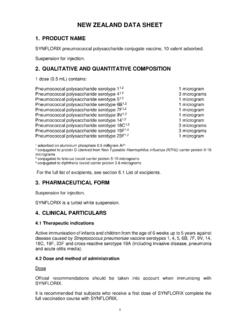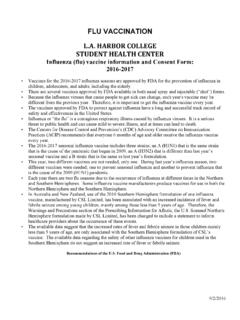Transcription of Don’t Be Guilty of These Preventable Errors in …
1 Is your healthcare setting making any of These frequently reported Errors in administering vaccines? Although some of These Errors are much more serious than others, none of them should occur. Be sure those who administer vaccines are not making any of These Preventable Errors in vaccine : Information about reporting vaccine administration Errors is found at the end of this : Not using a screening checklist to identify patients contraindications and precautions to vaccinationHow to Avoid This Error: Always use a reliable screening question-naire to consistently avoid either 1) giving a vaccine to a patient for whom it is contraindicated (a serious, potentially life-threatening situation), or 2) missing opportunities to vaccinate because of false contraindications (which can also be life-threatening, as they can leave a patient exposed to a vaccine - Preventable disease).
2 Helpful Resources: Use IAC s screening checklists, such as Screening Checklist for Contraindications to Vaccines for Children and Teens and Screening Checklist for Contraindications to Vaccines for Adults (both reviewed by CDC) available at CDC s vaccine Contraindications and Precautions web page: general- : Administering the wrong vaccine due to similarities in vaccine names ( , DTaP for Tdap, zoster for varicella, PPSV23 for PCV13)How to Avoid This Error: Check the vial label 3 TIMES! Such Errors often involve vaccines whose generic or trade names look or sound alike ( , Tdap and DTaP, Adacel and Daptacel), or that have similar packaging, so store such vaccines separately and mark them clearly in your storage unit as well as on the patient s vaccine tray. Other times, vaccines are mixed up when vaccinating multiple family members, such as siblings, on the same visit.
3 Pre-pare vaccines needed for one family member at a time, and always verify names and birthdates for the patient receiving the to do after such an error: The parent/patient should be told the wrong vaccine was given. Provide the correct vaccine , if neces-sary, with correct spacing, if necessary (for more details about specific situations, check Ask the Experts [ experts] under the relevant vaccine section, or email CDC for advice). Assess how this error happened to ensure it will not happen again. Helpful Resource: Institute for Safe Medication Practices (ISMP) Recommendations for Practitioners to Prevent vaccine Errors : : Using the wrong diluent or administering the diluent onlyHow to Avoid This Error: Use careful labeling in your vaccine storage unit. Keep vaccines and their diluents together if storage requirements are the same.
4 Check the vial and diluents labels 3 TIMES before reconstituting vaccine . Administering the diluent only is most likely to happen with the two vaccines that include antigen in their liquid component, Menveo and to do after such an error: Diluent Errors could affect the potency of the vaccine antigen administered, or the patient might not get the full benefit of the vaccine if the diluent not given con-tains antigen. If the wrong diluent is used, the vaccine needs to be repeated (except in the case of mixing up the diluent between MMR, MMRV, varicella, and zoster vaccines which are all made by Merck and use the same sterile water diluent).If an INACTIVATED vaccine is reconstituted with the wrong diluent and is administered, the dose is invalid and should be repeated ASAP. If a LIVE vaccine is reconstituted with the wrong diluent and is administered, the dose is invalid and if it can t be repeated on the same clinic day, it needs to be repeated no earlier than four weeks after the invalid dose.
5 This spacing is due to the effects of generating a partial immune response that could suppress the live replication of subsequent doses, even of the same live virus s diluent contains the C, Y, and W-135 serogroups, and the lyophilized vaccine component ( , freeze-dried powder) contains serogroup A. If the patient receives only the diluent, he or she is not protected against invasive meningococcal disease caused by Neisseria meningitidis serogroup A. Serogroup A disease is very rare in the United States but common in some other coun-tries. If the recipient of the C-Y-W diluent-only dose does not plan to travel outside the , then the dose does not need to be repeated. Otherwise, the dose should be repeated with either correctly reconstituted Menveo or with a dose of Menactra. There is no minimum interval between the incorrect dose and the repeat Pentacel, the liquid DTaP-IPV component given alone can count as valid doses of DTaP and IPV vaccines.
6 You cannot mix the leftover Hib component (lyophilized powder) with sterile water. ActHib must ONLY be reconstituted with either the DTaP-IPV solution supplied with Pentacel, or with a specific ActHib saline diluent. You must contact the manufacturer to obtain dilu-ent for the extra ActHib Resource: Vaccines with Diluents: How to Use Them on the next page Don t Be Guilty of These Preventable Error s in vaccine administration !Technical content reviewed by the Centers for Disease Control and PreventionSaint Paul, Minnesota 651-6 47-9009 Item #P3033 (10/17)error: Administering a vaccine after the expiration dateHow to Avoid This Error: If a vaccine is even one day over its expi-ration date, it should not be used. Rotate stock in your storage unit (which means make sure your vaccine that expires soonest is the closest to the front and easiest to reach in your storage unit), and establish a regular schedule for checking your storage unit for expired to do after such an error: If a dose of expired dose is inadver-tently given, it should be repeated.
7 If the expired dose is a live virus vaccine , you must wait at least 4 weeks after the expired dose was given before repeating it. The repeat dose of an expired inactivated vaccine can be given on the same day or any other time. If you prefer, you can perform serologic testing to check for immunity for certain vaccinations ( , measles, rubella, hepatitis A, and tetanus), although this may be more expensive and may produce negative test results, and if so, revaccination would be Resources: CDC s vaccine Storage and Handling Toolkit (pages 32 36): : Administering vaccine in the wrong site or by the wrong routeHow to Avoid This Error: In your vaccine preparation area, post reference materials that show the site and the route for each vaccine for each age group so that those who administer vaccines can easily verify the administration site and route for all vaccines and for all ages.
8 Highlight or otherwise mark the route informa-tion on the package. What to do after such an error: The deltoid muscle is the preferred site for intramuscular (IM) injection for children age 3 years and older and adults, although the anterolateral thigh can be used as a secondary choice. The anterolateral thigh is the site of choice for infants and toddlers under age 3 years; the deltoid is a secondary injection site for IM injections with toddlers if the muscle mass is adequate. For deltoid injections, care must be taken to avoid injection too high on the upper arm where injury to the shoulder could result (referred to as Shoulder Injury Related to vaccine administration , or SIRVA). Although the gluteus muscle is not a recommended site for vaccination, in general a dose given there can be considered valid.
9 The exceptions to this general rule are hepatitis B, rabies and HPV vaccines, which should not be consid-ered valid if administered in any site other than the deltoid or anterolateral thigh. Although vaccines should always be given by the route recom-mended by the manufacturer, if a vaccine is given by the wrong route (subcutaneously (Subcut) instead of IM, or IM instead of Subcut), it doesn t need to be repeated with the following four exceptions: hepatitis B, rabies, HPV, and inactivated influenza vaccine that is labeled for IM administration given by any route other than IM should not be counted as valid and should be repeated. vaccine given intradermally, except the intradermal influenza vaccine , is not valid and should be Resources: Administering Vaccines: Dose, Route, Site, and Needle Size: Vaccines to Adults: Dose, Route, Site, and Needle Size: to Administer Intramuscular and Subcutaneous vaccine Injections: to Administer Intramuscular and Subcutaneous vaccine Injections to Adults: to Administer Intradermal, Intranasal, and Oral Vaccinations: s General Best Practice Guidelines for Immunization at , pages 95 the Experts: # : Giving a vaccine dose earlier than the recommended age or intervalHow to Avoid This Error: Know the minimum intervals for all vaccine series.
10 Keep an easy-to-read immunization schedule handy for staff as well as the CDC table of minimum intervals. If you still aren t sure if a dose will be valid, check with your state immunization program before giving it. Attempt to locate old vaccination records by contact-ing previous healthcare providers and reviewing your state to do after such an error: A dose administered 5 or more days earlier than the recommended minimum interval between doses is not valid and should be repeated. The repeat dose should be spaced after the INVALID dose by the recommended minimum interval. Doses administered 5 or more days before the minimum age should be repeated on or after the patient reaches the minimum age. If the vaccine is a live vaccine , waiting at least 28 days from the invalid dose is recommended.
